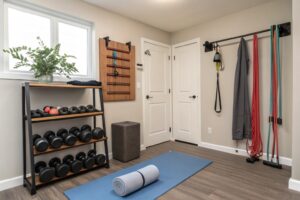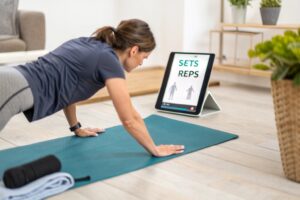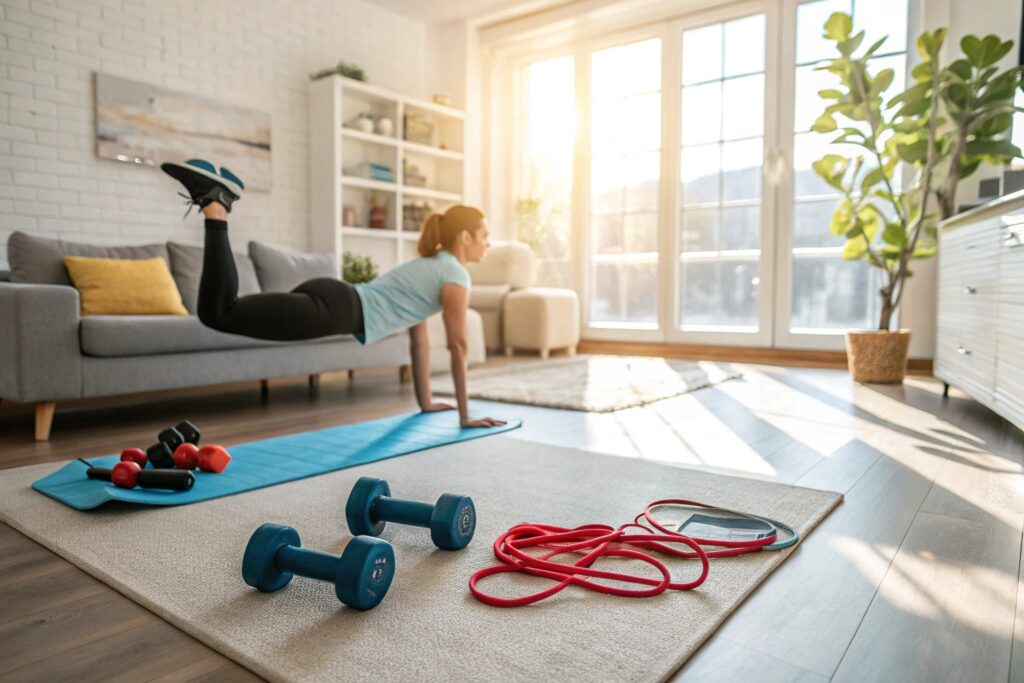The Rise of Home Workouts: How to Get Fit Without Leaving Your House is more than a trend—it’s a lasting shift in the way we think about health, convenience, and personal empowerment. With gyms closing, technology advancing, and busy schedules demanding flexibility, millions are turning to living‑room circuits, YouTube classes, and smart‑device coaching to stay lean, strong, and energized—all without stepping outside.
In this comprehensive guide we’ll explore the forces driving the home‑fitness boom, break down the science behind effective indoor training, and give you a detailed, actionable plan to design a personalized workout space that fits any budget and lifestyle.
Whether you’re a beginner who’s never set foot in a gym or a seasoned athlete looking for a low‑maintenance supplement to your routine, the strategies inside will help you maximize results, avoid common pitfalls, and keep motivation high—all from the comfort of your own home.
The Pandemic Sparked a Permanent Shift: Why Home Workouts Are Here to Stay
Global Health Crises Accelerated Adoption
When COVID‑19 shuttered gyms worldwide, the sudden loss of a familiar training venue forced millions to improvise. Studies from the American College of Sports Medicine showed a 63 % surge in home‑exercise app downloads in 2020 alone, and that momentum has not faded. People discovered that a well‑structured routine doesn’t require a costly membership—just space, time, and a willingness to learn.
Technology Makes It Easy to Replicate the Club Experience
Smartphones, Bluetooth wearables, and streaming platforms have turned any room into a virtual fitness studio. Apps like Fitbod, Peloton Digital, and Apple Fitness+ use AI to customize sets, track heart‑rate zones, and provide real‑time coaching cues, bridging the gap between professional trainers and home users.
Economic Incentives Drive Long‑Term Commitment
According to a 2023 survey by the International Health, Racquet & Sportsclub Association (IHRSA), the average gym membership costs $58 per month, while a modest home‑gym setup (dumbbells, resistance bands, a mat, and a streaming subscription) can be under $150 total. The savings quickly compound, making home workouts a financially sustainable habit for families and individuals alike.
Privacy, Comfort, and Personalization
Not everyone feels comfortable sharing their fitness journey in a public setting. Home workouts eliminate judgment, allow for flexible scheduling, and enable users to tailor environments (music, lighting, temperature) to maximize performance and enjoyment.
All these factors combine to make the home‑ model a permanent pillar of the wellness industry—one that continues to grow as new technologies and creative content emerge.
Designing an Effective Home Gym on Any Budget

Start With the Essentials: Bodyweight Basics
Before you invest in equipment, master bodyweight movements—push‑ups, squats, lunges, planks, and burpees. These exercises engage multiple muscle groups, improve functional strength, and require zero equipment. A well‑structured bodyweight routine can burn 300‑500 calories in 30 minutes, depending on intensity.
Essential Low‑Cost Gear That Delivers Big Returns
When you’re ready to add resistance, focus on versatile, space‑saving items:
- Adjustable Dumbbells (5‑50 lb): Replace an entire rack of plates.
- Resistance Bands (Light‑to‑Heavy): Perfect for mobility work, strength circuits, and rehab.
- Fold‑able Yoga Mat: Provides cushioning for floor work and can double as a cardio mat.
- Jump Rope: One of the most efficient cardio tools—up to 10 calories per minute.
Collectively, these items can be purchased for under $200 and occupy less than 10 sq ft.
Smart Furniture & Multi‑Purpose Solutions
Consider items that serve dual functions: a sturdy coffee table can become a step‑up platform, a bookshelf can hold kettlebells, and a wall‑mounted pull‑up bar fits over a doorway without drilling. IKEA’s Bekant sit‑stand desk, for instance, doubles as a bench for dumbbell presses when the tabletop is lowered.
Incremental Upgrades: When to Add Bigger Equipment
Once you’ve built consistency, evaluate your goals. If you’re focusing on strength, a compact power rack (under‑door) and a set of kettlebells (10‑40 lb) will expand exercise variety. For cardio lovers, a fold‑away treadmill or a compact rowing machine (e.g., water‑rowers) can be added without sacrificing floor space.
Remember: The most successful home gyms evolve with the user. Start small, master core movements, and upgrade strategically based on performance data from your fitness app or wearable.
How to Structure a Home Workout Plan That Actually Works

Determine Your Primary Goal: Strength, Hypertrophy, Endurance, or Mobility
Each goal dictates set‑reps schemes:
- Strength: 4‑6 reps, 4‑5 sets, 85‑95 % of 1RM (one‑rep max).
- Hypertrophy (muscle size): 8‑12 reps, 3‑4 sets, 70‑80 % of 1RM.
- Endurance/Cardio: 12‑20+ reps or continuous activity 20‑45 min.
- Mobility/Flexibility: 15‑30 sec holds, 2‑3 sets per joint.
Use a simple spreadsheet or the “FitNotes” app to record weight, reps, and perceived effort (RPE) each session.
Weekly Split Options for Home Environments
Given limited equipment, full‑body workouts three times weekly (Mon‑Wed‑Fri) are optimal for beginners. Intermediate lifters can adopt an upper‑lower split (e.g., Mon/Thu Upper, Tue/Fri Lower) while still using bodyweight and dumbbells. For cardio enthusiasts, add a low‑impact HIIT or steady‑state session on off days.
Periodization: Keep Progressing By Cycling Intensity
Every 4–6 weeks, modify one variable (load, volume, rest) to prevent plateaus. A simple linear progression might look like:
Weeks 1‑2: 3 sets × 10 reps @ 60 % 1RM.
Weeks 3‑4: 4 sets × 8 reps @ 70 % 1RM.
Weeks 5‑6: 5 sets × 6 reps @ 80 % 1RM.
After the cycle, deload (reduce weight by 30 % for one week) then restart at a higher baseline.
Incorporate Mobility & Recovery
Spend at least 10 minutes after each workout on dynamic stretching, foam rolling, or yoga poses (downward dog, child’s pose, hip flexor stretch). This reduces soreness, improves joint range, and supports long‑term adherence.
By aligning your programming with clear, measurable objectives, you turn “working out at home” from a casual habit into a data‑driven performance system capable of delivering real, quantifiable results.
Staying Consistent: Motivation, Accountability, and Community for Home Trainers
Leverage Digital Communities
Platforms such as Reddit r/homegym, Discord fitness servers, and Facebook groups host thousands of members sharing progress photos, workout templates, and encouragement. Engaging with a community creates social proof and a sense of belonging, which studies link to a 22 % increase in workout adherence.
Use Gamified Apps to Turn Exercise into a Game
Apps like Zombies, Run! and Fitocracy convert daily workout mileage into missions and points. This “reward loop” releases dopamine, making it easier to push through plateaus and low‑energy days. Set Micro‑Goals and Celebrate Wins
Instead of vague statements like “I’ll get fit,” define concrete, time‑bound targets: “Complete 3 full‑body sessions this week,” or “Increase dumbbell squat weight by 5 lb in two weeks.” Celebrate each achievement with a non‑food reward (new workout shirt, a massage, or a new playlist).
Virtual Personal Trainers & Live Classes
Many streaming services now provide live‑class options featuring certified trainers who can offer real‑time feedback via webcam. Booking a recurring class (e.g., “Monday 6 pm HIIT”) mimics a scheduled gym session, preserving the external accountability that many people miss when training alone.
Track Progress Visually
Take a weekly photo, record body measurements, or log a personal best (PB) in a notebook. Visual data points create a tangible narrative of improvement, reinforcing motivation when motivation wanes.
Consistently applying at least three of these tactics builds a robust support structure that far outweighs the “lonely workout” stereotype often associated with home fitness.
Top 7 Mistakes Home Exercisers Make (And How to Fix Them)
Mistake #1: Skipping Warm‑Up
Jumping straight into a heavy set spikes injury risk. Allocate 5‑10 minutes to dynamic movements (leg swings, arm circles, inchworms). A proper warm‑up raises muscle temperature by 2‑3 °C, improving power output and reducing strain.
Mistake #2: Over‑relying on One Type of Exercise
Doing only bodyweight squats or endless cardio ignores muscular balance. Follow the “push‑pull‑legs” principle to ensure all major muscle groups are addressed weekly.
Mistake #3: Ignoring Progression
Sticking to the same weight or reps for months stalls hypertrophy. Apply progressive overload principles—add weight, increase reps, or shorten rest intervals every 1‑2 weeks.
Mistake #4: Poor Form Due to Lack of Feedback
Without a trainer’s eye, form can deteriorate. Use a mirror, record videos, or join live‑stream classes where coaches can correct you in real time.
Mistake #5: Inadequate Recovery
Training every day without rest leads to overtraining syndrome (fatigue, decreased performance). Schedule at least one complete rest day per week and incorporate active recovery (light walk, gentle yoga).
Mistake #6: Neglecting Nutrition
Fitness isn’t just about exercise. Align your macro intake with goals: 1.6‑2.2 g protein per kg bodyweight for muscle maintenance, adequate carbs for energy, and healthy fats for hormone balance.
Mistake #7: Not Setting Up a Dedicated Space
Working on a cluttered couch leads to distractions and unsafe movements. Clear a defined area—preferably a corner with a non‑slip mat—to mentally cue “workout mode” and physically protect equipment.
Addressing these pitfalls early on transforms a casual home‑gym experiment into a sustainable, results‑driven lifestyle.
By following the strategies outlined above, you’ll harness the full power of the Rise of Home Workouts: How to Get Fit Without Leaving Your House. From budget‑friendly equipment and science‑backed programming to motivation hacks and error prevention, you now have a complete roadmap to achieve lasting fitness—all from the comfort of your own space.
Ready to start? Grab a set of resistance bands, fire up your favorite streaming class, and commit to just 30 minutes today. Your future self will thank you.


